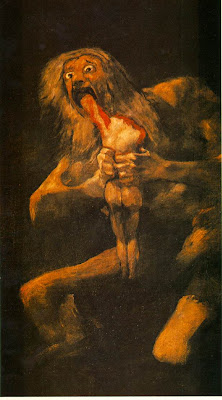Cannibalism : Rituals and beliefs

On a primitive level, ritually eating part of the slaughtered enemy is a way of assuming the life-spirit of the departed. In a funeral ritual this may also be done with a respected member of one's own clan, ensuring immortality. Cannibal ogresses appear in folklore around the world, the witch in 'Hansel and Gretel' being the most immediate example. The opening of Hell, the Zoroastrian contribution to Western mythology, is a mouth. According to Catholic dogma, bread and wine are transubstantiated into the real flesh and blood of Jesus, which are then distributed by the priest to the faithful. For this reason, Catholics in pagan times were sometimes accused of cannibalism by suspicious non-Christians.The Christians in turn accused their opponents, such as the Gnostic sect of the Borborites, for cannibalism and ritual abuse.
In the Qur'an slanderers are stigmatized as those who eat the flesh of the dead body of the person they slander.
.jpg)
The Aghori are a Hindu sect believed to have split off from the Kapalika order (which dates from 1000 A.D.) in the fourteenth century. Both Kapalika & Aghori sects are worshipers of Lord Shiva. Aghori means non-terrifying in Sanskrit, and may refer to how members of the sect view death. This extremely secretive community is known to live in graveyards, wear the ash from the pyre, and use human bone from the graveyards for the rituals.
Members of the Aghori drink from human skulls and practice cannibalism in the belief that eating human flesh confers spiritual and psyhical benefits, such as prevention of aging.
The Aghori are widely censured in India for their use of human remains. The sect is said to practice human sacrifice, however this has not been confirmed and many believe it to be unlikely. It is also believed that Aghoris perfrom Tantric ritual involving sex with a lower caste, menstruating woman during which the aghori becomes shiva and his partner shakti. Their history of cannibalism was attested by a sixteenth century persian and nineteeth century British accounts. The main akhada of Aghoris is Kina Ram's Ashram in Varanasi. Kina Ram's samadhi is a centre of piligrimage for aghoris and aghori devotees.


Comments
Post a Comment